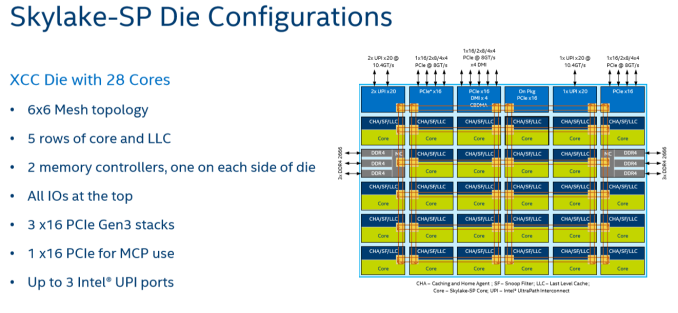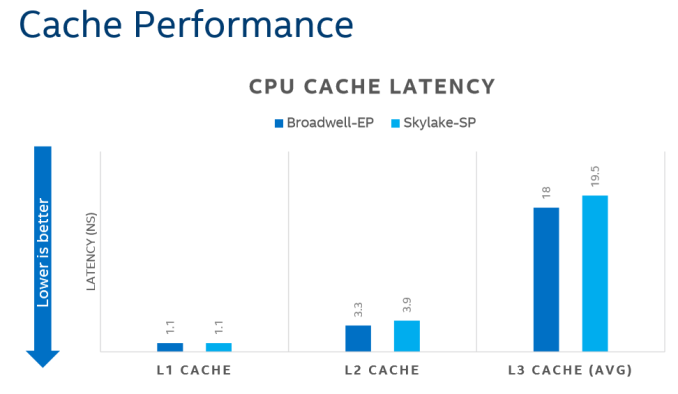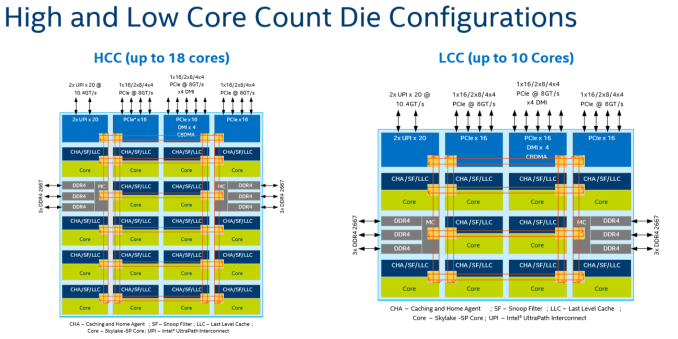Sizing Up Servers: Intel's Skylake-SP Xeon versus AMD's EPYC 7000 - The Server CPU Battle of the Decade?
by Johan De Gelas & Ian Cutress on July 11, 2017 12:15 PM EST- Posted in
- CPUs
- AMD
- Intel
- Xeon
- Enterprise
- Skylake
- Zen
- Naples
- Skylake-SP
- EPYC
Intel's New On-Chip Topology: A Mesh
Since the introduction of the "Nehalem" CPU architecture – and the Xeon 5500 that started almost a decade-long reign for Intel in the datacenter – Intel's engineers have relied upon a low latency, high bandwidth ring to connect their cores with their caches, memory controllers, and I/O controllers.
Intel's most recent adjustment to their ring topology came with the Ivy Bridge-EP (Xeon E5 2600 v2) family of CPUs. The top models were the first with three columns of cores connected by a dual ring bus, which utilized both outer and inner rings. The rings moved data in opposite directions (clockwise/counter-clockwise) in order to minimize latency by allowing data to take the shortest path to the destination. As data is brought onto the ring infrastructure, it must be scheduled so that it does not collide with previous data.
The ring topology had a lot of advantages. It ran very fast, up to 3 GHz. As result, the L3-cache latency was pretty low: if the core is lucky enough to find the data in its own cache slice, only one extra cycle is needed (on top of the normal L1-L2-L3 latency). Getting a cacheline of another slice can cost up to 12 cycles, with an average cost of 6 cycles.
However the ring model started show its limits on the high core count versions of the Xeon E5 v3, which had no less than four columns of cores and LLC slices, making scheduling very complicated: Intel had to segregate the dual ring buses and integrate buffered switches. Keeping cache coherency performant also became more and more complex: some applications gained quite a bit of performance by choosing the right snoop filter mode (or alternatively, lost a lot of performance if they didn't pick the right mode). For example, our OpenFOAM benchmark performance improved by almost 20% by choosing "Home Snoop" mode, while many easy to scale, compute-intensive applications preferred "Cluster On Die" snooping mode.
In other words, placing 22 (E7:24) cores, several PCIe controllers, and several memory controllers was close to the limit what a dual ring could support. In order to support an even larger number of cores than the Xeon v4 family, Intel would have to add a third ring, and ultimately connecting 3 rings with 6 columns of cores each would be overly complex.
Given that, it shouldn't come as a surprise that Intel's engineers decided to use a different topology for Skylake-SP to connect up to 28 cores with the "uncore." Intel's new solution? A mesh architecture.
Under Intel's new topology, each node – a caching/home agent, a core, and a chunk of LLC – is interconnected via a mesh. Conceptually it is very similar to the mesh found on Xeon Phi, but not quite the same. In the long-run the mesh is far more scalable than Intel's previous ring topology, allowing Intel to connect many more nodes in the future.
How does it compare to the ring architecture? The Ring could run at up to 3 GHz, while the current mesh and L3-cache runs at at between 1.8GHZ and 2.4GHz. On top of that, the mesh inside the top Skylake-SP SKUs has to support more cores, which further increases the latency. Still, according to Intel the average latency to the L3-cache is only 10% higher, and the power usage is lower.
A core that access an L3-cache slice that is very close (like the ones vertically above each other) gets an additional latency of 1 cycle per hop. An access to a cache slice that is vertically 2 hops away needs 2 cycles, and one that is 2 hops away horizontally needs 3 cycles. A core from the bottom that needs to access a cache slice at the top needs only 4 cycles. Horizontally, you get a latency of 9 cycles at the most. So despite the fact that this Mesh connects 6 extra cores verse Broadwell-EP, it delivers an average latency in the same ballpark (even slightly better) as the former's dual ring architecture with 22 cores (6 cycles average).
Meanwhile the worst case scenario – getting data from the right top node to the bottom left node – should demand around 13 cycles. And before you get too concerned with that number, keep in mind that it compares very favorably with any off die communication that has to happen between different dies in (AMD's) Multi Chip Module (MCM), with the Skylake-SP's latency being around one-tenth of EPYC's. It is crystal clear that there will be some situations where Intel's server chip scales better than AMD's solution.
There are other advantages that help Intel's mesh scale: for example, caching and home agents are now distributed, with each core getting one. This reduces snoop traffic and reduces snoop latency. Also, the number of snoop modes is reduced: no longer do you need to choose between home snoop or early snoop. A "cluster-on-die" mode is still supported: it is now called sub-NUMA Cluster or SNC. With SNC you can divide the huge Intel server chips into two NUMA domains to lower the latency of the LLC (but potentially reduce the hitrate) and limit the snoop broadcasts to one SNC domain.














219 Comments
View All Comments
Shankar1962 - Wednesday, July 12, 2017 - link
AMD is fooling everyone one by showing more cores, pci lanes, security etcCan someone explain me why GOOGLE ATT AWS ALIBABA etc upgraded to sky lake when AMD IS SUPERIOR FOR HALF THE PRICE?
Shankar1962 - Wednesday, July 12, 2017 - link
Sorry its BaiduPretty sure Alibaba will upgrade
https://www.google.com/amp/s/seekingalpha.com/amp/...
PixyMisa - Thursday, July 13, 2017 - link
Lots of reasons.1. Epyc is brand new. You can bet that every major server customer has it in testing, but it could easily be a year before they're ready to deploy.
2. Functions like ESXi hot migration may not be supported on Epyc yet, and certainly not between Epyc and Intel.
3. Those companies don't pay the same prices we do. Amazon have customised CPUs for AWS - not a different die, but a particular spec that isn't on Intel's product list.
There's no trick here. This is what AMD did before, back in 2006.
blublub - Tuesday, July 11, 2017 - link
I kinda miss Infinity Fabric on my Haswell CPU and it seems to only have on die - so why is that missing on Haswell wehen Ryzen is an exact copy?blublub - Tuesday, July 11, 2017 - link
argh that post did get lost.zappor - Tuesday, July 11, 2017 - link
4.4.0 kernel?! That's not good for single-die Zen and must be even worse for Epyc!AMD's Ryzen Will Really Like A Newer Linux Kernel:
https://www.phoronix.com/scan.php?page=news_item&a...
Kernel 4.10 gives Linux support for AMD Ryzen multithreading:
http://www.pcworld.com/article/3176323/linux/kerne...
JohanAnandtech - Friday, July 21, 2017 - link
We will update to a more updated kernel once the hardware update for 16.04 LTS is available. Should be August according to Ubuntukwalker - Tuesday, July 11, 2017 - link
You mention an OpenFOAM benchmark when talking about the new mesh topology but it wasn't included in the article. Any way you could post that? We are trying to evaluate EPYC vs Skylake for CFD applications.JohanAnandtech - Friday, July 21, 2017 - link
Any suggestion on a good OpenFoam benchmark that is available? Our realworld example is not compatible with the latest OpenFoam versions. Just send me an e-mail, if you can assist.Lolimaster - Tuesday, July 11, 2017 - link
AMD's lego design where basically every CCX can be used in whatever config they want be either consumer/HEDT or server is superior in the multicore era.Cheaper to produce, cheaper to sell, huge profits.